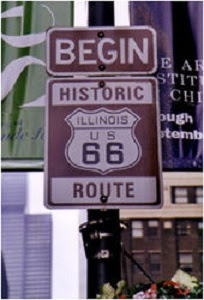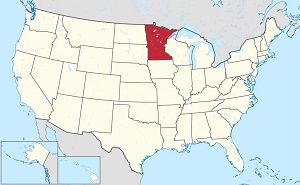Illinois
Missouri Oklahoma Kansas Texas New Mexico Arizona California
U.S. Route 66 also known as the Will Rogers Highway, the Main Street of America and the Mother Road, was one of the original
highways in the United States. Established on November 11, 1926, it became one
of the most famous roads in America, running from Chicago to Santa Monica
California and covering 2448 miles – 3940 Km.
This Road served as a major path for those who migrated west,
especially during the Dust Bowl of the 1930s, and was instrumental in the
growth of the communities through which it passed. People doing business along
the route became prosperous due its growing popularity.
The Highway ceased to be a part of the US Highway System in 1985; it
was replaced in its entirety by segments of the Interstate Highway System.
Portions of the road that passed through Illinois, Missouri, New Mexico, and
Arizona have been designated National Scenic Byways and named Historic
Route 66.
Several states have adopted significant
bypassed sections of the former US 66 into the state road network as State
Route 66.
Chicago
Springfield and the Mississippi River 301
miles - 484 km. Chicago is
the Gateway to the Midwest and the start of your Route 66 journey. From this great
American city’s magnificent architecture, excellent cuisine, the shops on
Michigan Avenue and beaches along Lakeshore, you go to Springfield, the
Illinois State Capitol and President Lincoln’s home and National Historic Site
which preserves the only home Abraham Lincoln ever owned. Start your journey
along the mother road, savoring its small towns and scenic beauty with
stopovers at the Route 66 Experience and Route 66 Museum respectively in Joliet
and Berwyn. Also, Pontiac and pie at the Palms Grill Café.
Cozy Dog Drive In this Route 66 diner became a
part of the history of the Road when inventor Ed Waldmire introduced the famous
"hot dog on a stick" in 1946. Inside, find an amusing selection of
Route 66 memorabilia, souvenirs, and tasty treats.
An Architectural Walking Tour of Historic Downtown Springfield
The Abraham Lincoln Presidential Library and
Museum brings
together the world’s largest collection of material related to Abraham Lincoln.
The museum features hi-tech exhibits, interactive displays, multimedia programs
and a reproduction of the White House as it looked in 1861.
Shea’s Gas Station Museum is a collection of gas
station memorabilia spanning over 66 years.
The Brick Road this 1.4 stretch of historic
brick road is on the National Register of Historic Places.
Logistics
Locations Costs Time and Personalization Solutions
Missouri US 66
covered 292 mile - 470 km - in this
state, passing through Joplin, Carthage, Springfield, home of the first
drive-thru, and St Louis.
Oklahoma and Kansas the
highway covered 267 miles - 430 km - in Oklahoma. Today, it is marked by
I-40 west of Oklahoma City; after entering at Texola, US 66 passed through
Sayre and Elk City on the way to Tulsa. Past there, US 66 passed through
northeastern Oklahoma before entering Kansas where it covered only 13.2 miles -
21.2 km - passing only three towns: Galena, Riverton and Baxter Springs.
Texas the
Midpoint Café’ in Adrian Texas is the midpoint of the route. US 66 covered
178 miles - 286 km - in the Texas Panhandle, travelling in a west-east
line, passing through Amarillo.
New Mexico US 66
covered 380 miles - 610 km - and passed through many Indian reservations
in the western half of New Mexico. East of those reservations, the highway
passed through Albuquerque and Sante Fe.
Arizona
the highway originally covered 401 miles - 645 km – paralleling I-40, passing
through the ghost town of Oatman. Between Kingman and Seligman, the route is
still signed as SR 66.
California US 66 had its western terminus at the Pacific Coast Highway in
California, covering 315 miles - 507 km - in the state running through San
Bernardino, Los Angeles and Santa Monica and intersecting with US 101, in
Hollywood.
Connect with Tema
receive
a detailed travel plan
and
Travel the USA on Route 66
Local
Knowledge – Global Reach
tema@arezza.net skype arezza1

















